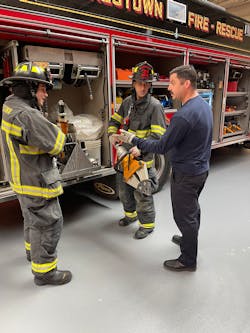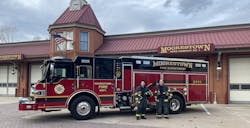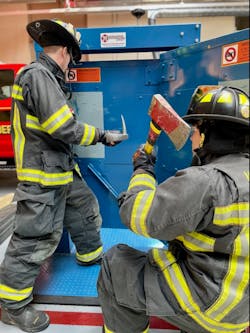Robust & Thorough: Partnering to Cover the Response Gap
Moorestown, NJ, Fire Department (MFD) Fire Police Capt. Peter Clifford, along with the Board of Fire Commissioners and members of the fire department, felt the pressure of declining membership in their volunteer department and wanted to act. What emerged was a concept to develop a partnership with a local college that would ensure that adequate fire protection, occupational training and potential employment opportunities were accessible for citizens throughout the county.
From concept to concrete plan
The original memorandum of understanding between Moorestown Fire District No. 1 and Rowan College of Burlington County (RCBC) was signed in June of 2018, but talks between the college and the fire district started long before the stroke of the pen and the shake of hands.
Clifford, who is a life member of Relief Engine Company, brought the idea of partnering with RCBC to the Board of Fire Commissioners and Fire District Administrator Chris Chesner soon after he came up with it. Not long after that, the Board of Fire Commissioners and other leaders agreed that the idea was worth pursuing. Meetings were arranged with RCBC, and what once were conceptual ideas developed into a concrete plan.
The agreement had two options: Students would receive a 10 percent reduction in tuition if they volunteered eight hours per week during the semester or $1,500 toward tuition per semester (paid by the MFD) if students volunteered a total of 16 hours per week. (Books, course materials and fees would be excluded.) Either of the two paths required the student to be at the station during daytime hours to cover the response gap that the department was trying to tackle.
As talks progressed and the policy developed, requirements were discussed. To be considered, students would need to hold a Firefighter 1 Division of Fire Safety certification from the state of New Jersey, which includes hazmat operations and awareness, as well as a few other basic certifications. Students would need to be at least 18 years of age. They only would be eligible when they were declared physically fit to perform the vocational duties of a volunteer firefighter and when they successfully completed a background check.
All student members would attend department drills twice per month or, if they were a member of a different fire station, provide a letter from the chief or training officer of their respective department as evidence of training, at the discretion of the MFD fire chief and/or MFD training officer. They also would be required to meet and maintain their requirement for conduct, attendance and training in accordance with department regulations. Students also would be required to pass their courses to receive the tuition reimbursement.
Clifford and representatives from RCBC annually attend the first day of class for Firefighter 1 to explain the program to students. If any students believe that they will be interested in joining the program after they obtain their Firefighter 1 certification, the representatives from RCBC will register them. Later, if students decide to move forward, they receive seven college credits for attending Firefighter 1.
Clifford also attends all graduation ceremonies for Firefighter 1 classes and speaks to the students and families to remind them of the program and its benefits.Smooth implementation
Training Officer Bart Santaspirt is tasked with the implementation of the program, with taking those who applied through the onboarding process and with overseeing the day-to-day operation of the program.
Once the initial candidates were recruited, the implementation of the program was relatively smooth. Applications were filled out and reviewed and offers of membership, consistent with the new category of membership, were made. The new members were given their medical screenings and background checks and began their initial mandatory training. Once complete, the members were given an orientation and overview of the MFD and its operations, standard operating procedures and standard operating guidelines. The members were issued their PPE and set up in a workspace where they were able to complete their schoolwork between answering calls.
The members can schedule their time with the training officer based on their class schedule. On any given day, as many as two extra firefighters are available to answer the alarm.
Unsurprisingly, given their base level of training, including a Firefighter 1 certification, new members can be put in service essentially immediately after orientation.
In New Jersey, the Firefighter 1 program is approximately 212 hours spread out over six months. Although that certainly is a worthwhile investment in a person who walks in off of the street for the department, the return comes much later than is the case in a circumstance that involves an RCBC/MFD recruit.
Paying dividends
The first participant in the program proved that the collaborative work between the college and department was worthwhile.
“Matt” was in the equipment room with Santaspirt when the bell rang for a brush fire along a stretch of freight train tracks that bisects the township. Everyone donned their PPE and boarded the apparatus. On arrival, it was found that a train that had a stuck brake was throwing sparks along the entirety of the tracks from township border to township border (roughly nine miles), which ignited a series of brush fires. One of the fires encroached on a nearby house.
The engine was redirected to the structure, and the crew extinguished the fire and mitigated the threat. The quick response from the station, which included the newly minted student member, was paramount in saving the house from burning.
Response time to the multiple fires along the railroad tracks was quicker, because the department had an extra certified firefighter.
“Daytime response always has been a challenge for many volunteer departments nationwide, and the MFD is no exception,” Santaspirt says. “However, with our newly minted firefighter, response time was quicker to the multiple fires along the railroad tracks, as we had an extra certified firefighter in the firehouse.”
In the end, because of the geographical span of the fire, multiple command posts needed to be set up, with mutual-aid companies responding to assist with the prolonged operation.
The community benefits
Now in its third year, the program has proved to be a success. The creative solution to a common and growing problem is a testament to the ingenuity and determination of a group of people whose goal it is to ensure that Moorestown’s residents, businesses, patrons and visitors receive the highest level of services.
About the Author
Chris Chesner
Chris Chesner is Moorestown, NJ, Fire Department’s (MFD) fire district administrator. He oversees the daily operations of the fire district. One of the first firefighters in the MFD’s Junior program, Chesner has amassed 30 years of experience. He held various ranks within the department, including fire official and deputy chief. Chesner received a Bachelor of Arts in economics and business administration from Belmont Abbey College and a Bachelor of Science in fire science from University of Maryland University College.
Bart Santaspirt
Bart Santaspirt is the Moorestown, NJ, Fire Department’s (MFD) training officer. He oversees the training and education of the 56 members who are assigned to one of two stations. Starting in the volunteer fire service in MFD’s Junior program, Santaspirt has 20 years of experience. He held various ranks within the organization, up to and including battalion chief. Currently, Santaspirt holds the rank of captain, assigned to Station 311, Hose Company No. 1. He received a bachelor's degree in history from Gettysburg College and a master's degree in education from Holy Family University.


